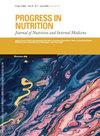葡萄糖和果糖对大鼠体重及一些生化指标的影响
4区 医学
Q4 Agricultural and Biological Sciences
引用次数: 6
摘要
目的:从高果糖玉米糖浆等添加糖中提取的果糖可能会导致肥胖、高脂血症、心血管疾病、高尿酸血症和脂肪肝等主要风险。本研究旨在探讨和比较高果糖和高葡萄糖摄入对大鼠体重和一些生化指标的影响。实验对象和方法:选用Wistar白化雄性成年大鼠32只(300 ~ 350 g周),饲喂标准实验室饲料。每组随机选取8只大鼠,分为4组。各组大鼠在标准餐的基础上,灌胃不同剂量的葡萄糖和果糖溶液(10%和30%葡萄糖饲喂组,10%和30%果糖饲喂组),持续6周。测定大鼠基线及6周后总胆固醇、vldl -胆固醇、甘油三酯、尿酸、AST、ALT等生化指标及肝脏组织病理学检查。每周评估大鼠体重。结果:30%果糖组AST水平高于10%葡萄糖组、30%葡萄糖组和10%果糖组。6周结束时,果糖饲喂组的平均体重高于葡萄糖饲喂组(p < 0.05)。各组间门静脉炎症发生率无统计学差异,30%果糖大鼠出现中、重度球囊化(p<0.05)。结论:因此,从高果糖玉米糖浆等添加糖中获取的膳食果糖可能导致严重的代谢紊乱。本文章由计算机程序翻译,如有差异,请以英文原文为准。
The effects of glucose and fructose on body weight and some biochemical parameters in rats
Objective: Dietary fructose from added sugar as high fructose corn syrup may causes major risks in obesity, hyperlipidemia, cardiovascular diseases, hyperuricemia and fatty liver. The aim of this study was to investigate and compare the effects of high fructose and high glucose intake on body weight and some biochemical parameters in rats. Subject and methods: The study was conducted on adult, 32 Wistar albino male rats (300-350 g weeks) which fed with standard laboratory chow. In each group, 8 rats was selected randomly and which was be composed four groups. The rats in each group, in addition to standard meal, different amount of glucose and fructose containing solutions (10% and 30% glucose-fed group, 10% and 30% fructose-fed group) was given by oral gavage for 6 weeks. At baseline and after 6 weeks total cholesterol, VLDL-cholesterol, triglycerides, uric acid, AST and ALT as biochemical parameters and liver histopathological examination of rats were determined. Body weight of the rats was evaluated every week. Results:The 30% fructose group caused higher AST levels according to 10% glucose group, 30% glucose group and 10% fructose group. At the end of 6 weeks, the mean body weight in the fructose-fed groups was higher than the glucose-fed groups (p>0.05). No statistically significant difference between rat groups’ portal inflammation rates were found and the moderate and severe ballooning were observed in 30% fructose rats (p<0.05). Conclusions: As a result, dietary fructose from added sugar as high fructose corn syrup may causes major metabolic disorders.
求助全文
通过发布文献求助,成功后即可免费获取论文全文。
去求助
来源期刊

Progress in Nutrition
医学-营养学
CiteScore
1.40
自引率
0.00%
发文量
0
审稿时长
>12 weeks
期刊介绍:
Progress in Nutrition was founded in 1999 as an independent magazine, a multidisciplinary approach, dedicated to issues of nutrition and metabolism.
 求助内容:
求助内容: 应助结果提醒方式:
应助结果提醒方式:


